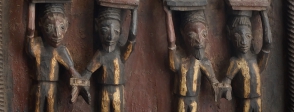The first four activities focus on getting students to look closely at and discuss the object. Others move on to wider aspects of colonial rule.
Show students close-up images and details of the door panels. Explain briefly the occasion that the panels depict. Help them to identify and comment on the different characters: the Ogoga, his queen, Captain Ambrose, the porters and what they are carrying, the prisoners, soldiers, animals etc.
Ask students to compare the carving of the meeting on the doors with the photograph in For the classroom. Ask them to study the images carefully and to compare how the participants are shown, especially in terms of dress and poses. Ask students which of the figures they think is depicted as having the most power and why that might be. Do these two images produce similar or different responses in the viewer and how might a Nigerian and British viewer differ?
Ask students if they can name any African country that was colonised by a European country and which European country they think was the colonising power. Show students a map of Africa in the early 20th century and identify the colonial powers. Explore how this situation came about during the period 1880 – 1900, known as the Scramble for Africa.
Use the coins and banknotes on A bigger picture to explore how they reinforce the authority of the colonising power. Encourage the students to identify any elements that are distinctive of the colony. Then compare the examples from former colonies after independence looking at how the elements have changed.


